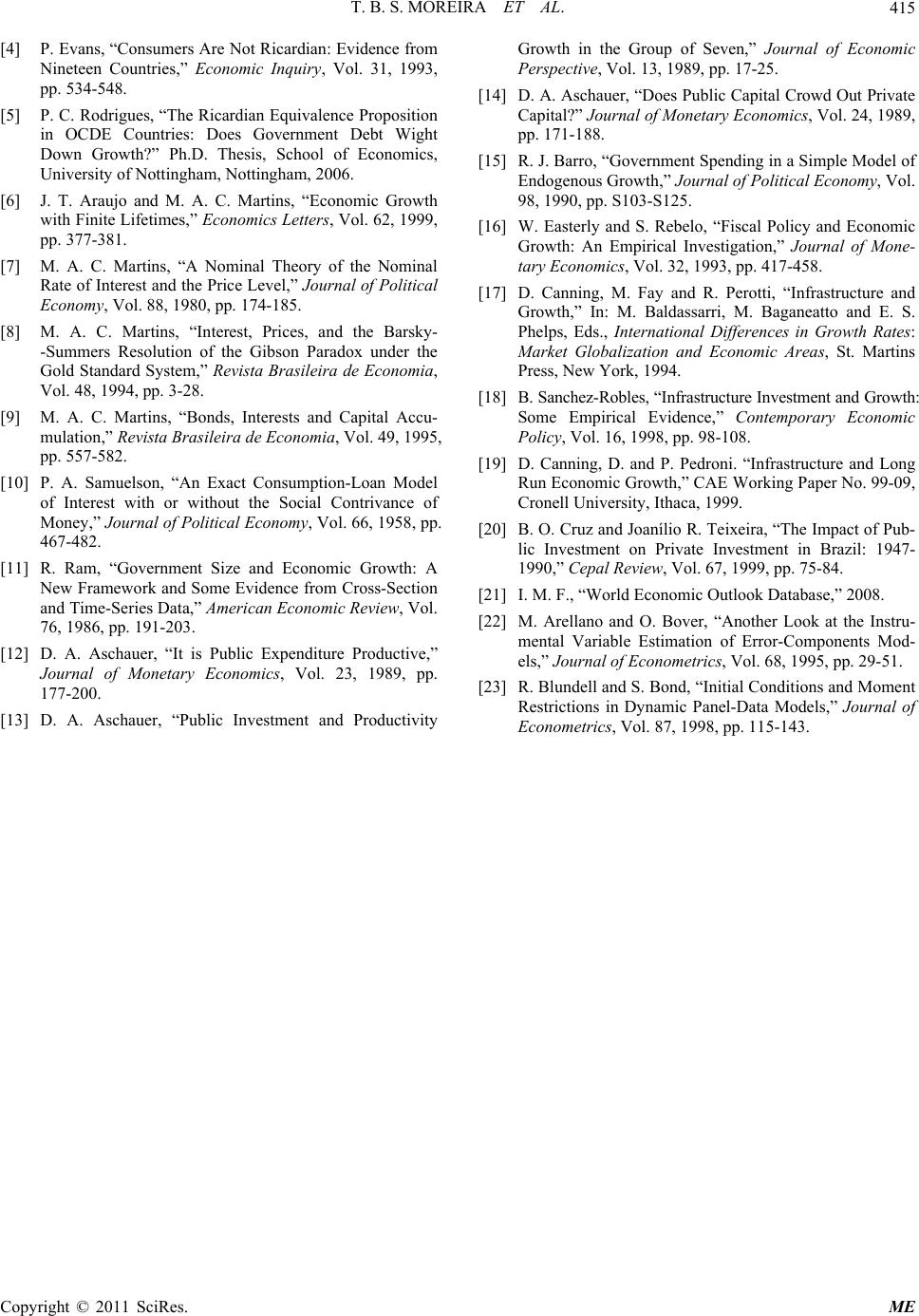
T. B. S. MOREIRA ET AL.
Copyright © 2011 SciRes. ME
415
[4] P. Evans, “Consumers Are Not Ricardian: Evidence from
Nineteen Countries,” Economic Inquiry, Vol. 31, 1993,
pp. 534-548.
[5] P. C. Rodrigues, “The Ricardian Equivalence Proposition
in OCDE Countries: Does Government Debt Wight
Down Growth?” Ph.D. Thesis, School of Economics,
University of Nottingham, Nottingham, 2006.
[6] J. T. Araujo and M. A. C. Martins, “Economic Growth
with Finite Lifetimes,” Economics Letters, Vol. 62, 1999,
pp. 377-381.
[7] M. A. C. Martins, “A Nominal Theory of the Nominal
Rate of Interest and the Price Level,” Journal of Political
Economy, Vol. 88, 1980, pp. 174-185.
[8] M. A. C. Martins, “Interest, Prices, and the Barsky-
-Summers Resolution of the Gibson Paradox under the
Gold Standard System,” Revista Brasileira de Economia,
Vol. 48, 1994, pp. 3-28.
[9] M. A. C. Martins, “Bonds, Interests and Capital Accu-
mulation,” Revista Brasileira de Economia, Vol. 49, 1995,
pp. 557-582.
[10] P. A. Samuelson, “An Exact Consumption-Loan Model
of Interest with or without the Social Contrivance of
Money,” Journal of Political Economy, Vol. 66, 1958, pp.
467-482.
[11] R. Ram, “Government Size and Economic Growth: A
New Framework and Some Evidence from Cross-Section
and Time-Series Data,” American Economic Review, Vol.
76, 1986, pp. 191-203.
[12] D. A. Aschauer, “It is Public Expenditure Productive,”
Journal of Monetary Economics, Vol. 23, 1989, pp.
177-200.
[13] D. A. Aschauer, “Public Investment and Productivity
Growth in the Group of Seven,” Journal of Economic
Perspective, Vol. 13, 1989, pp. 17-25.
[14] D. A. Aschauer, “Does Public Capi tal Crowd Out Private
Capital?” Journal of Monetary Economics, Vol. 24, 1989,
pp. 171-188.
[15] R. J. Barro, “Government Spending in a Simple Model of
Endogenous Growth,” Journal of Political Economy, Vol.
98, 1990, pp. S103-S125.
[16] W. Easterly and S. Rebelo, “Fiscal Policy and Economic
Growth: An Empirical Investigation,” Journal of Mone-
tary Economics, Vol. 32, 1993, pp. 417-458.
[17] D. Canning, M. Fay and R. Perotti, “Infrastructure and
Growth,” In: M. Baldassarri, M. Baganeatto and E. S.
Phelps, Eds., International Differences in Growth Rates:
Market Globalization and Economic Areas, St. Martins
Press, New York, 1994.
[18] B. Sanchez-Robles, “Infrastructur e Investment and Gro wth:
Some Empirical Evidence,” Contemporary Economic
Policy, Vol. 16, 1998, pp. 98-108.
[19] D. Canning, D. and P. Pedroni. “Infrastructure and Long
Run Economic Growth,” CAE Working Paper No. 99-09,
Cronell University, Ithaca, 1999.
[20] B. O. Cruz and Joanílio R. Teixeira, “The Impact of Pub-
lic Investment on Private Investment in Brazil: 1947-
1990,” Cepal Review, Vol. 67, 1999, pp. 75-84.
[21] I. M. F., “World Economic Outlook Database,” 2008.
[22] M. Arellano and O. Bover, “Another Look at the Instru-
mental Variable Estimation of Error-Components Mod-
els,” Journal of Econometrics, Vol. 68, 1995, pp. 29-51.
[23] R. Blundell and S. Bond, “Initial Conditions and Moment
Restrictions in Dynamic Panel-Data Models,” Journal of
Econometrics, Vol. 87, 1998, pp. 115-143.